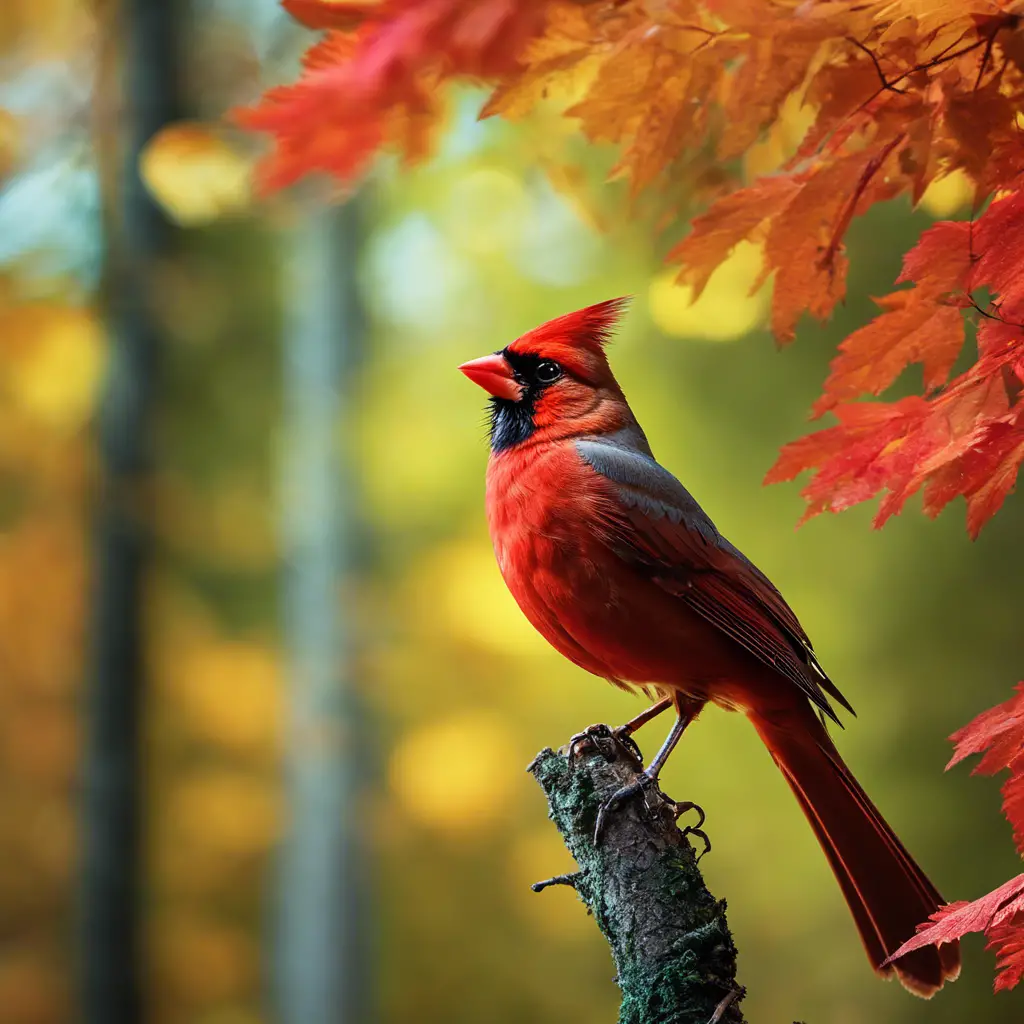Through a series of detailed images and accurate data, we are proud to showcase the most popular birds in Uganda. Our reliable sources were authenticated by an Ornithologist for authentication purposes.
Common ostrich (Struthio camelus)

The common ostrich is one of the most recognizable birds of Uganda. It is easily identified by its long neck, large size and white feathers. The common ostrich can reach up to 2.7 meters tall and can weigh up to 156 kgs.
Common ostriches are mainly found in open grassy plains, savannas, deserts and shrublands. In Uganda, they inhabit areas such as Murchison Falls and Queen Elizabeth National Parks where there is plenty of space to roam and enough food to sustain their diet. Their diet consists mainly of plants but they will also consume insects, small reptiles, and other vertebrates.
Common ostriches are usually found in pairs or small family groups. They communicate by making loud, booming calls as well as visual signals like bowing and head bobbing. The male will usually take the lead in courtship displays and can be quite aggressive when defending its territory.
Common ostriches are considered to be important for their role in local ecosystems and Uganda’s tourism industry. Through their eating habits, they help keep vegetation in check and provide food for other animals. They also attract visitors to the country’s national parks with their spectacular size and behavior.

Shoebill (Balaeniceps rex)
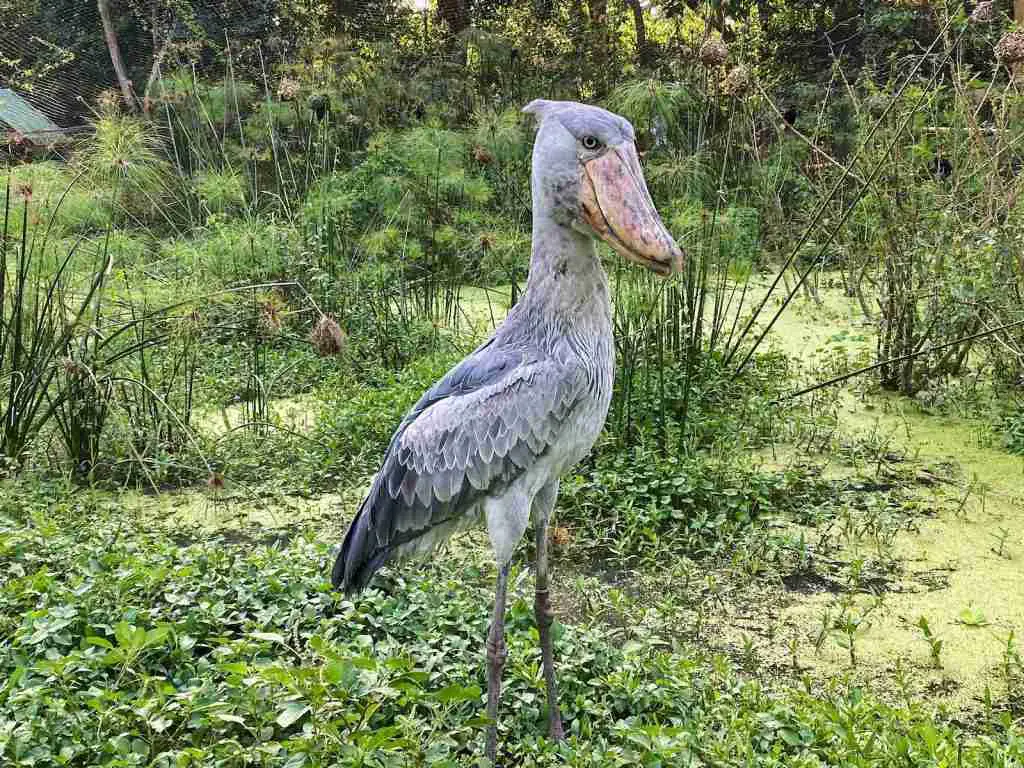
Shoebill is a large bird native to Uganda and other parts of East Africa. It has distinctive characteristics, such as its shoe-like bill and long neck. Its plumage is mostly grey but the neck feathers have a brownish tinge. The Shoebill typically stands between 1 – 1.5 m tall, with an average wingspan of 2 – 2.5 m.
The Shoebill’s diet consists of mostly fish, frogs and other small aquatic animals. It lives in swamps and wetlands, where it uses its long neck to detect prey. It feeds either by standing still in shallow water or by wading around searching for prey. Its powerful bill is used to catch the prey and then swallow it whole.
The Shoebill is typically a solitary bird but can be found in groups of up to six individuals. It is an excellent swimmer and can even use its wings as flippers when swimming underwater. During the breeding season, the Shoebill will call out with loud hissing noises to attract a mate. The nest is typically built on an elevated platform and consists of sticks, dry grasses, leaves, and reeds. The female will lay a clutch of two eggs which are incubated for about 30 days until they hatch.

Goliath heron (Ardea goliath)

The Goliath herons are large wading native Uganda birds. It is the largest of all herons, with adults reaching up to 4 feet tall and weighing up to 6 pounds. Goliath heron has long legs and a long neck. Its feathers are predominantly grey or white, with black and brown markings on its wings and tail.
Goliath heron has a varied diet, including small reptiles and mammals, as well as fish and crustaceans. It catches its prey with a quick strike using its long neck and sharp claws.
Goliath heron is found in wetlands throughout Uganda; it prefers shallow, still bodies of water such as swamps, marshes, flooded fields, and rivers. It is a solitary bird, and usually only seen in pairs during the breeding season. Goliath heron nests in trees, often near water, typically forming large colonies with other herons or storks.
Goliath heron hunts during the day; it stands patiently watching for prey and then strikes quickly when it sees an opportunity.

Saddle-billed Stork (Ephippiorhynchus senegalensis)

Saddle-billed Stork is a large wading bird found in Uganda. It is easily distinguished by its unique bill, which is yellow, with a black saddle-shaped band across the middle. This species can reach up to 1.5m in height and weighs up to 4kg, making it one of the largest storks in Africa. Its plumage is mostly white and black, with yellow tips on its wings.
Saddle-billed Storks inhabit freshwater wetlands and grasslands of Uganda, where they feed mainly on fish, frogs, reptiles, small mammals and insects. They also have been known to scavenge for carrion. The birds often congregate in large groups while feeding or roosting, and they also form pairs during the breeding season. It is not uncommon for Saddle-billed Storks to migrate up to 500km in search of better food sources or seasonal temperatures.

Marabou Stork

Marabou Stork is one of the largest birds in Uganda and can be identified by its long, dark legs and white body. It has a bald head and neck, with a black crest above its eyes. This bird is an opportunistic scavenger and feeds on carrion, small animals, fish and garbage. Its size ranges from 75 – 150 centimeters with a wingspan of up to 3 meters. It inhabits open areas such as grassland, savanna, and wetlands, near human settlements or large bodies of water.
They are usually found in flocks and their behavior includes soaring high in the air, gathering food from the ground, perching on trees or buildings, and nesting in colonies. Marabou Storks are a protected species in Uganda and can be found all over the country.
The Marabou Stork is an amazing bird! With its unique physical characteristics, varied diet, impressive size, diverse habitat, and interesting behavior it makes an incredible sight to behold while visiting Uganda. Be sure to keep an eye out for this majestic bird on your next safari adventure!

Secretary Bird
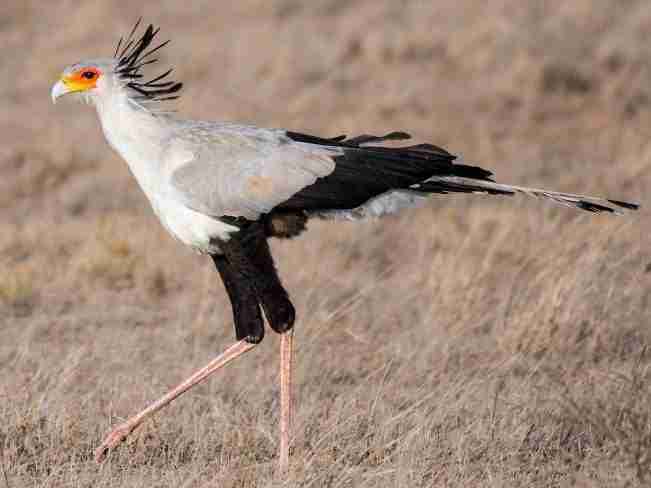
Secretary Bird is a large, terrestrial bird identified by its long legs and crest feathers. It is typically found in open grasslands and savannas of Uganda and other parts of Africa. It has a rather large size with an average height of 107 cm (42 inches) and weight ranging from 2–4 kg (4-8 lbs).
The Secretary Bird is an opportunistic feeder, consuming prey such as lizards, rodents, birds, insects and snakes. It has a unique hunting technique of stamping the ground in order to flush out its prey which it then catches with its strong talons.
The Secretary Bird typically lives in pairs or small family groups and is well adapted to living in dry habitats. It is an active species and can often be seen soaring high above the ground in search of food, as well as walking through grasslands on the hunt.
Its long legs make it a powerful bird of prey and its strong wings help it to fly at great speeds in pursuit of prey or for escaping predators. It is also able to defend itself by kicking at attackers with its sharp talons.

Great Blue Turaco (Corythaeola cristata)
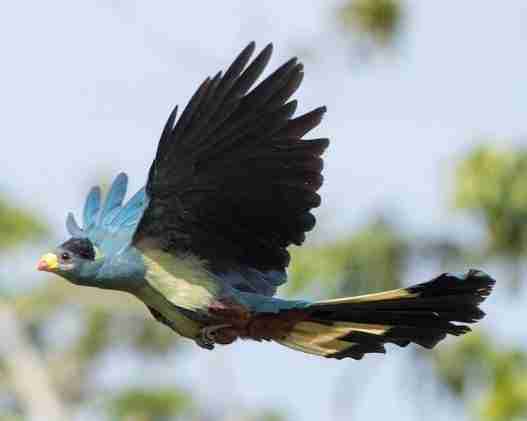
Great Blue Turaco is a large, colorful bird species found in Uganda. It has a bright blue-green head, turquoise blue body, yellow bill, and bright red eyes. Juvenile birds have brownish heads and duller colors overall. Its diet consists mainly of fruits, seeds and flowers, although it will also eat small insects on occasion.
Great Blue Turacos typically measure between 38 and 43 cm in length, with a wing span of about 60 cm. They are found mainly in the tropical forests of Uganda, but also inhabit other wooded areas such as open savannah and gallery forests.
These birds live in groups of up to 20 individuals, although they may form flocks of hundreds during migration or when searching for food. They are arboreal and forage most often in the canopy of trees, but may also visit lower levels to search for food or to bathe. Their vocalizations include a variety of harsh grunts and screams that travel quite far through the air.
Great Blue Turacos are known to be shy around humans, and will usually fly away if approached or disturbed. They are important to their environment as seed dispersed, helping to maintain the natural balance of plant species in their habitat.

African Spoonbill

Platalea alba, is a large bird native to Uganda. It has a bright white plumage with black wingtips, long legs, and a bill. It also has pink facial skin, yellow eyes, and an orange-colored patch near the base of its bill. African Spoonbill typically grows to be around 80 cm (31 inches) in length and weighs 1.2 kg (2.6 pounds).
African Spoonbill mainly feeds on aquatic life, such as crustaceans, molluscs, small fish, and amphibians. They also sometimes eat insects, frogs, and worms. The bird uses its long bill to sweep through shallow water in search of food. It then closes its bill quickly when it comes across prey.
African Spoonbill is usually found near wetlands, rivers, and lakes in Uganda. It usually feeds alone or in small groups of up to 20 birds, but larger flocks often form during the winter months. During the mating season, these birds also gather together in large breeding colonies. African Spoonbill is quite a social bird and can often be seen interacting with other birds, such as egrets and herons.
In flight, the African Spoonbill has slow, powerful wing beats. They usually fly close to the ground or water surface in a straight line formation. This shy bird typically migrates between northern Uganda in summer and southern Africa in winter. It prefers to roost in trees or shrubs, which are usually close to the water’s edge.

Doherty’s Bushshrike
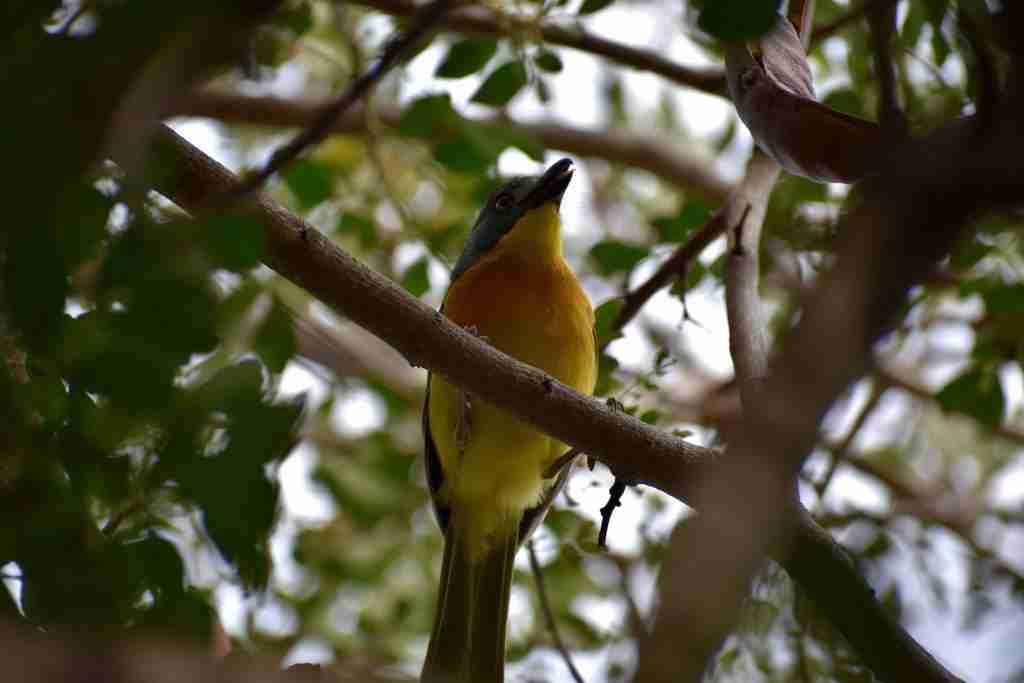
Doherty’s Bushshrike is a medium-sized bird found in Uganda. It has a grey head, black wings and back, white throat, chestnut belly and vent, and yellow eye ring. Its bill is curved and pointed with both upper and lower mandibles black in color.
As an omnivore, Doherty’s Bushshrike mainly feeds on insects, fruits and berries. It can also be observed foraging on the ground for food.
Doherty’s Bushshrike is typically around 18-19 cm in length, with a wingspan of roughly 32 cm. Its habitat includes dry shrubland, woodland and gardens.
In terms of behavior, this bird is often found in flocks, sometimes with other species of birds. Its call is a loud series of jumbled notes and it will often sing from the top of a bush or tree. Doherty’s Bushshrike also has an aggressive nature and will even attack larger birds that come too close to its nesting territory. It performs courtship displays before mating season by puffing out its chest and tail feathers. During the breeding season, the female will lay a clutch of one to two eggs in a shallow cup nest located in shrubs or trees. Both parents assist with incubating the eggs and rearing their young.

African Green Broadbill
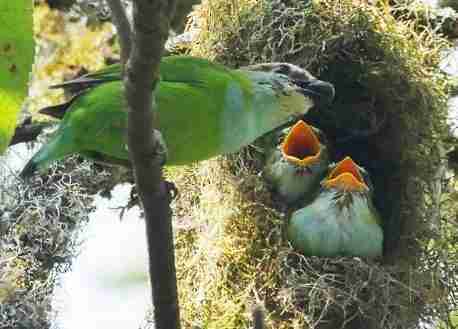
African Green Broadbill, also known as Pseudocalyptomena graueri, is a bird species endemic to Uganda. It has an unmistakable green plumage with black flight feathers, and a yellow-tipped tail. Adult males have a red crown and nape, while females are browner. They grow up to 15 cm in length and weigh just 10 g.
African Green Broadbills are insectivores, mainly consuming caterpillars and beetles. They inhabit montane evergreen forests, preferring the high canopy of tall trees. They can also be found in secondary growth forests, bamboo thickets, and gardens close to forested areas.
African Green Broadbills prefer to live solitarily. During the breeding season, pairs will form and the male will construct a dome-shaped nest from moss and cobwebs. The female then incubates the two eggs for approximately two weeks until they hatch.

Long-crested Eagle

Long-crested Eagle is a species of bird found in Uganda. It’s a medium-sized eagle, measuring from 54 to 68 cm (21 to 27 inches) in total length and weighing 1.2–2 kg (2.6–4.4 lb). It has grey wings, brown upperparts and white underparts with a black tail with two white bars. Its distinctive feature is the long crest of feathers on its head.
In terms of diet, Long-crested Eagles mostly feed on other birds, mammals and reptiles. They hunt by flying in circles searching for prey to swoop down on below.
The species inhabits open forests and savannahs, as well as mountainous areas and can also be found close to human settlements.
In terms of behavior, Long-crested Eagles are almost always seen alone or in pairs, but they sometimes form loose flocks with other species of eagle. They are mainly active during the day and roost at night in tall trees. Breeding takes place during the dry season, usually between August and December. A single egg is laid, which is incubated for about 44 days by both parents. The chicks are ready to leave the nest after 67–77 days and become independent at 11–12 weeks of age.

Standard-Winged Nightjar
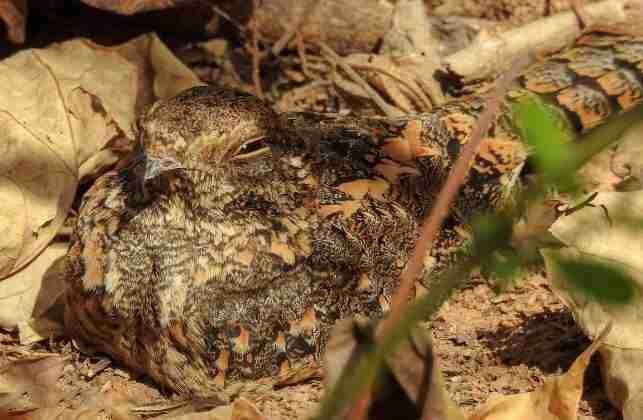
Standard-Winged Nightjar is a common species of nocturnal bird found in Uganda. It is typically small to medium-sized with an average length of around 10 inches and a wingspan of up to 22 inches. Its upperparts are usually brown or grayish in color, while its undersides are whitish with fine reddish bars on the chest and belly.
Its most distinctive feature is a pair of wings with white markings at the base of each feather.
The Standard-Winged Nightjar feeds primarily on insects, which it catches by flying low over open ground and snatching them up from the air or in mid-flight. It also takes advantage of secondary food sources such as fruit when available, and is known to feed on small mammals, reptiles, and amphibians.
Standard-Winged Nightjars are found in open grasslands, savannas, and wooded areas across Uganda. They usually roost during the day among dense vegetation or atop rocks or logs. At night they become more active, often flying rapidly over open ground in search of food. They are also known to roost communally during the breeding season, gathering in flocks that can number up to several hundred birds.
This species is quite vocal, emitting a wide range of calls throughout the night. Its most characteristic call is a loud rasping “khee-krra” which can often be heard echoing across the landscape on still nights. It is also known to produce a variety of soft whistles and chirps when perched or in flight.

Green breasted pitta
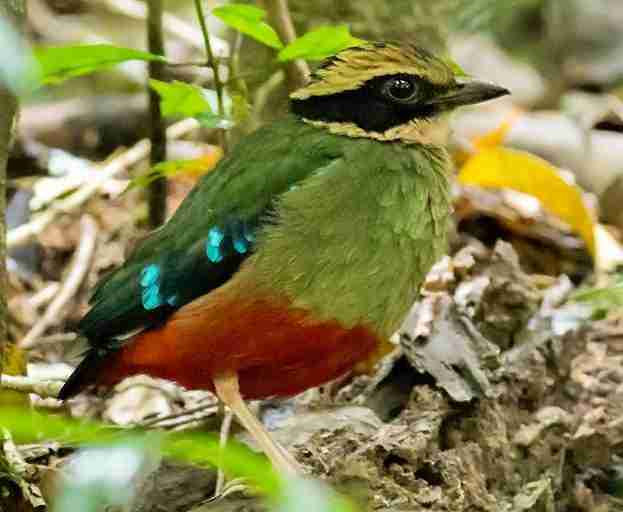
Green-breasted Pitta is a colorful species of passerine bird found in Uganda. It typically measures 20 cm (8 inches) long, with males slightly larger than females. Its plumage is mainly black with a green breast and red belly, while its head is grayish-blue and it has white tail feathers.
The Green-breasted Pitta mainly feeds on insects, although it will also take small fruits and berries when available. It prefers to forage from the ground where it can scratch through leaf litter looking for invertebrates.
In terms of habitat, Green-breasted Pittas inhabit moist forests, woodlands, thickets and primary forest habitat. They typically roost in low vegetation or on the ground, and are active during the day.
When breeding, Green-breasted Pittas build a shallow cup nest from leaves and twigs. The female lays 2–4 eggs which she incubates for around 17 days before they hatch. Once hatched, both parents feed the young until they fledge at around 23 days old.

Bar tailed trogon
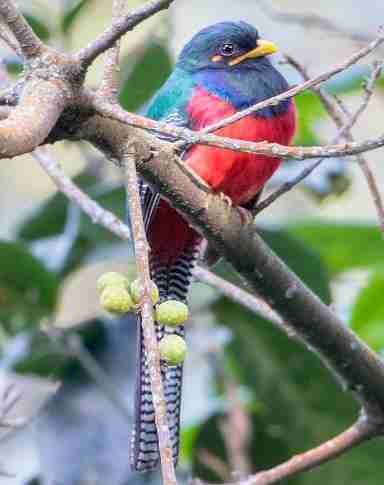
Bar-tailed Trogon is a species of bird found in Uganda. It measures around 40 cm (16 inches) long, with males slightly larger than females. Its plumage is mainly black and gray with white barring on the wings and tail. Its most distinctive feature is its bright orange bill, which it uses to feed on insects and fruits.
Bar-tailed Trogons inhabit evergreen and semi-deciduous forests as well as secondary woodland, where they often perch in the canopy. They feed on insects, small vertebrates, fruits and berries. They are active during the day and roost at night in dense foliage or on tree trunks.

African jacana
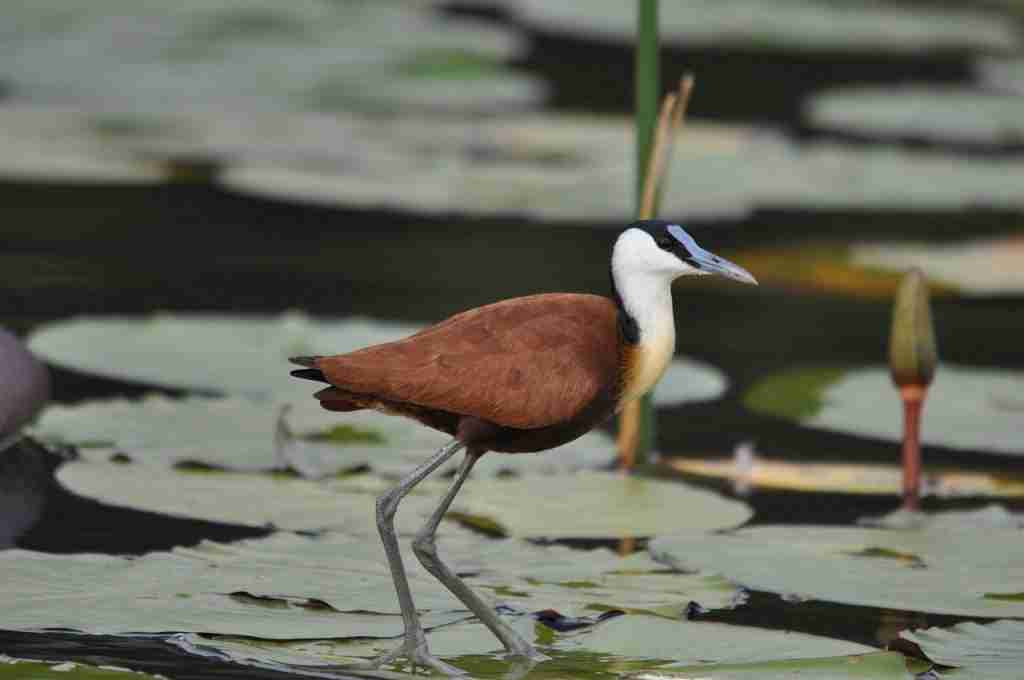
African jacana birds are native to Uganda and can be found around the continent in wetland habitats. They are easily identified by their long toes and claws, which allow them to walk on top of floating vegetation like lily pads. African jacanas have a diet that consists mainly of insects, seeds, worms, and mollusks.
Their wingspan measures approximately 25-30 cm and they weigh between 80-150 g. They are commonly found on shallow lakes, marshes, and ponds in Uganda’s savanna regions. African jacanas have a very interesting behavior: when mating, the males tend to do all of the nesting and incubating duties while their mates fly off to seek other mates.
This behavior, however, can also lead to some conflict between males over territory and eggs. These birds are often seen in groups of two or three and use their long toes to walk across the vegetation while they hunt for food.
African jacanas are important part of the ecosystem in Uganda because they help control insect populations, spread seeds, and aerate the soil. They are currently listed as a species of least concern, but their habitats need to be protected in order for them to continue to thrive.

Yellow-billed Oxpecker
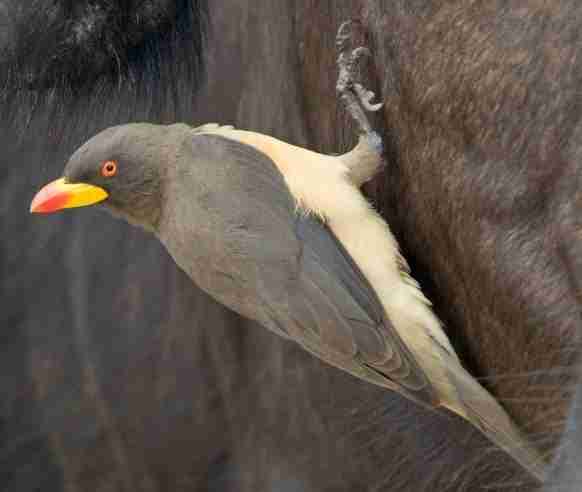
(Buphagus africanus) is a species of bird found in Uganda. It has a distinctive black and yellow plumage with a yellow bill, dark eyes and a slightly curved black beak. The adult birds reach a length of about 15 cm and weigh around 48 g.
The Yellow-billed Oxpecker primarily feeds on ticks and other external parasites of large mammals such as antelope, buffalo, giraffe, wildebeest and zebra. It also feeds on the new growth of grasslands during dry season and fruit in the wet season.
Yellow-billed Oxpeckers are found in open woodlands, savannas and grasslands across Uganda. They are usually seen near herds of large mammals, such as buffalo and zebra, on which they feed.
The behavior of the Yellow-billed Oxpecker is quite unique; they often perch on the backs of these large mammals to feed on ticks and other external parasites, as well as screeching from time to time to alert their host of predators or other potential danger. They also form long-term monogamous relationships, with pairs often staying together for many years. This species is highly social, and can often be seen in small flocks of up to 20 individuals.

Grey crowned crane (Balearica regulorum)
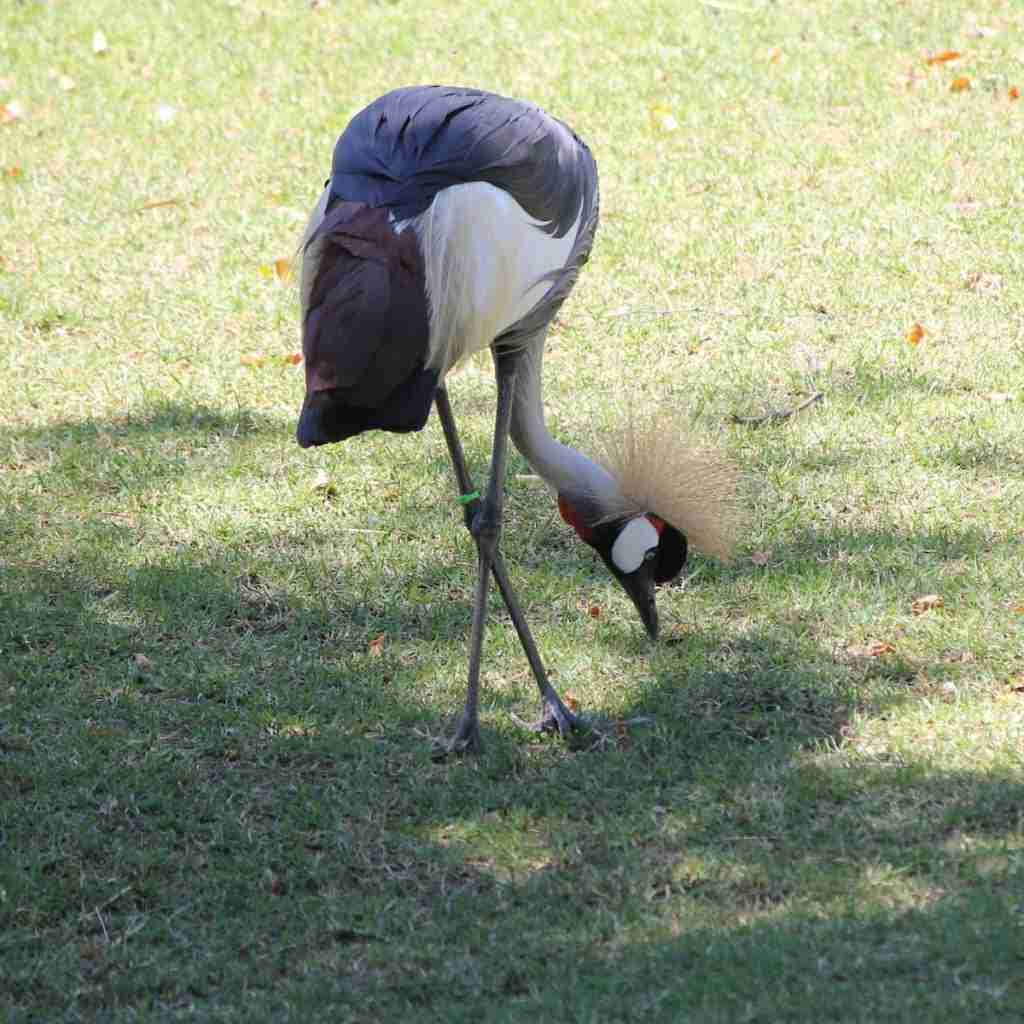
Grey crowned crane is a species of crane found in Uganda. It is the national bird of Uganda and is also known as the African crowned crane. This medium-sized bird has a distinctive crown of feathers on its head, giving it its name.
The grey crowned crane has an overall greyish-brown colouring with white patches near its wings and tail. Its neck, chest and head are a more yellowish-brown, which is where its distinctive crown of feathers can be found.
The grey crowned crane feeds on small invertebrates such as insects and reptiles, as well as seeds and grain. During the wet season they may also consume plant matter such as grasses. This species has an omnivorous diet and is also known to scavenge for food.
Grey crowned cranes are a medium sized species, with males typically reaching heights of 127 cm (50 in) and females slightly smaller at 110–120 cm (43–47 in). This makes them slightly larger than the great blue heron.

Chocolate-Backed Kingfisher
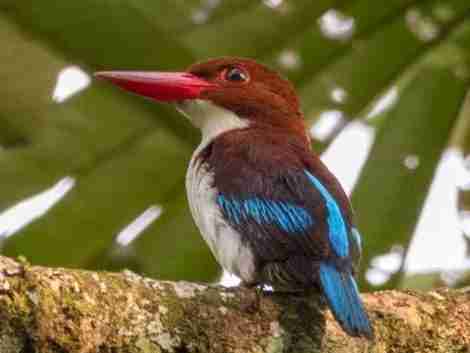
Chocolate-Backed Kingfisher is a medium-sized bird found in Uganda. It has a distinctive chocolate-brown back and white belly, with an orange crown and blue wings. It is typically 16–17 cm long and weighs between 15–25 g.
Chocolate-Backed Kingfishers are usually found near rivers, ponds, lakes, or wetlands in areas of dense vegetation. They feed on a variety of small fish, aquatic insects, frogs and earthworms which they catch by diving from a perch into the water.
These birds are typically solitary and do not form flocks or migrate. They are non-territorial and will move around periodically in search of new sources of food. They are generally found during the day, but can be heard calling at night.
Chocolate-Backed Kingfishers are known to nest in tree cavities or termite mounds. The female lays around three eggs per clutch which she incubates for about 20 days until they hatch. Both parents take turns feeding their young a mixture of fish, insects and slugs.

African paradise flycatcher (Terpsiphone viridis)
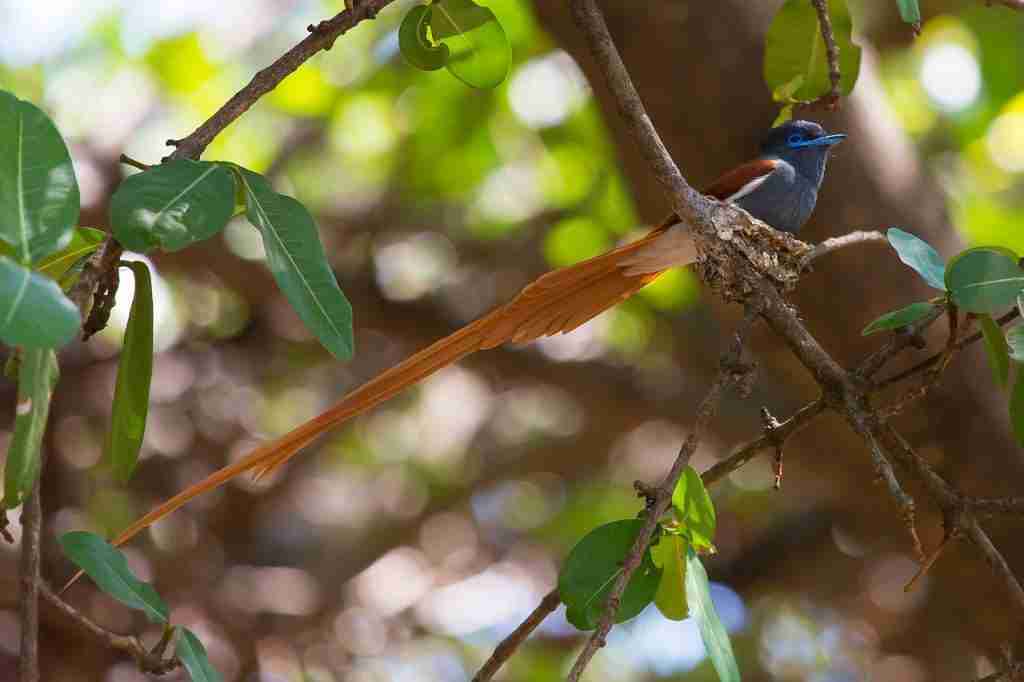
African paradise flycatcher is a medium-sized bird found in Uganda. It is easily recognisable by its strikingly long tail which makes it one of the most beautiful birds in the country. The adult male has chestnut upperparts, with a white rump, while the underparts are grey and faintly barred. The female is less colourful with mainly grey plumage.
African paradise flycatchers feed mainly on insects and other invertebrates, which they catch by waiting patiently on a perch or hunting in the air. They are fairly common throughout Uganda and can be seen in woodlands and open habitats. Their behaviour is quite active, chasing away potential competitors from their feeding areas. When breeding, the male will perform a special courtship flight, displaying the length and beauty of its tail. They typically build their nests in trees or shrubs. Breeding pairs may also build multiple nests as decoys to ward off predators.
The African paradise flycatcher is an important bird species for Uganda’s avian diversity and plays an important role in the country’s food web. They are a vital part of the ecosystem, consuming large amounts of insect pests. This provides an invaluable service for farmers and local communities, helping to protect their crops from damage.
With its distinctive appearance, this species is also a source of pride for Ugandans, who can admire its beauty in their natural surroundings. With the right conservation measures, the African paradise flycatcher can continue to thrive in Uganda’s habitats for many years to come.

Abyssinian ground hornbill (Bucorvus abyssinicus)

Abyssinian ground hornbill is a species of large bird found in Uganda. It has black feathers, with a white stripe on its throat and bright red facial skin. The abyssinian ground hornbill is the largest of the three species of African ground hornbills, weighing up to 9 kg (20 lbs).
This bird feeds mainly on insects, but also eats small reptiles, amphibians, and fruits. It searches for prey by walking on the ground or hopping from branch to branch in search of food items. The abyssinian ground hornbill generally inhabits dry forests and savannas but can also be found in woodlands.
This species is typically found in small groups of up to six birds. They are social, and can often be seen foraging together or engaging in communal displays of courtship. Additionally, adult birds have been observed caring for young chicks by both parents.
The abyssinian ground hornbill is considered to be a vulnerable species due to habitat loss and other human-related factors. Conservation efforts are underway to protect these birds and ensure their continued survival.

Black-Breasted Barbet

Black-Breasted Barbet is an African bird species usually found in Uganda. It is a small sized bird with bright colors, often having black and yellow markings on the head, back and wings. Its diet mainly consists of fruits and other plant matter that it finds in its natural habitat.
The Black-Breasted Barbet can usually be found inhabiting the forests of Uganda and the surrounding areas, often making its home in trees. They often forage for food near stream beds or amongst shrubs and vines within the forests.
Behaviour wise, these birds are usually solitary but can be seen in pairs during breeding season. During this time they tend to become more vocal and may even take part in courtship displays. They tend to build their nests in hollows of trees which are often lined with grass, leaves and hair.
The black-breasted barbet is an important species for the ecosystem of Uganda as they help disperse the seeds from fruits that they eat. This helps promote plant growth in the area, improving conditions for other wildlife and benefiting the local environment. Furthermore, they are a popular species amongst birdwatchers and provide an important source of ecological tourism for the country.

How many types of birds are in Uganda?
Uganda is home to more than 1,000 species of birds. These can include small songbirds such as weavers, larks and waxbills, large water birds such as storks and ibises, raptors like buzzards and eagles, gamebirds including guineafowls and francolins, the colourful sunbirds, kingfishers, and of course the spectacular flamingos.
Uganda is considered an important bird area (IBA) with several unique species restricted to the Albertine Rift including Rwenzori Turaco, Handsome Francolin, Grauer’s Rush Warbler, Archer’s Robin-Chat and Congo Bay Owl. Birding enthusiasts flock to Uganda from around the world to catch a glimpse of these magnificent birds. Bird watching is one of the most popular activities for visitors to Uganda.
Which bird is endemic to Uganda?
The Rwenzori Turaco is the only bird species that is found exclusively in Uganda. It can be found in several areas of the Rwenzori Mountains, including Kibale National Park and Queen Elizabeth National Park. The Rwenzori Turaco typically has a bright green back, blue neck feathers, and conspicuous yellow wattles on its head. This colourful bird is one of the most sought-after endemic species in Uganda, and a must-see for any avid bird lover!
What are some of the best spots to watch birds in Uganda?
The Mabamba Wetland near Entebbe is one of the best places to spot a variety of different water birds, including the rare Shoebill Stork. The shores of Lake Victoria and the Kasenyi Fishing Grounds in Queen Elizabeth National Park are also popular birding spots. Bwindi Impenetrable National Park is home to over 350 species of birds, while Murchison Falls National Park has some 300 species of birds that can be seen. The wetlands of Mabamba, located along the Nile, are an ideal spot for spotting many species of waterfowl. Finally, Kibale National Park is home to 13 species of primates including the endangered chimpanzee and also boasts more than 300 different bird species.
What is Uganda’s bird?
Uganda’s national bird is the grey crowned crane. This species of crane is found in several parts of Africa, including Uganda. The grey crowned crane is a distinctive bird with its ornate golden crown and white plumage. It has long legs and a curved bill which it uses to feed on seeds, insects, and other small prey. This species is considered to be a symbol of peace and prosperity in Uganda, which is why it was chosen as the national bird. The grey crowned crane is also listed as vulnerable by the International Union for Conservation of Nature (IUCN). As a result, conservation measures have been put in place to protect this species from further decline.
Does Uganda have parrots?
Yes, Uganda does have parrots. The most commonly seen species of parrot in Uganda is the African grey parrot which can be found in a variety of habitats including forests, savannas, and even some urban areas. These birds are highly intelligent and playful, making them popular pets for those living in or visiting Uganda. Other parrot species found in Uganda include the Rose-ringed Parakeet, Red-breasted Parakeet, and Meyer’s Parrot. All of these species are protected by law and their numbers are monitored as part of conservation efforts.

An avid ornithologist, zoologist and biologist with an unwavering passion for birds and wild animals.
Dr. Wilson’s journey in ornithology began in childhood and led him to obtain a Ph.D. in Ornithology from the prestigious Avian Research Institute. He has worked closely with renowned experts in the field and conducted extensive research and field studies globally.


